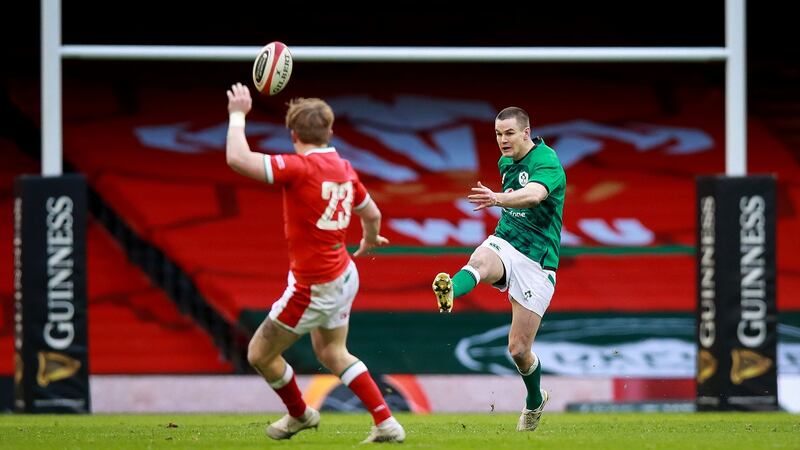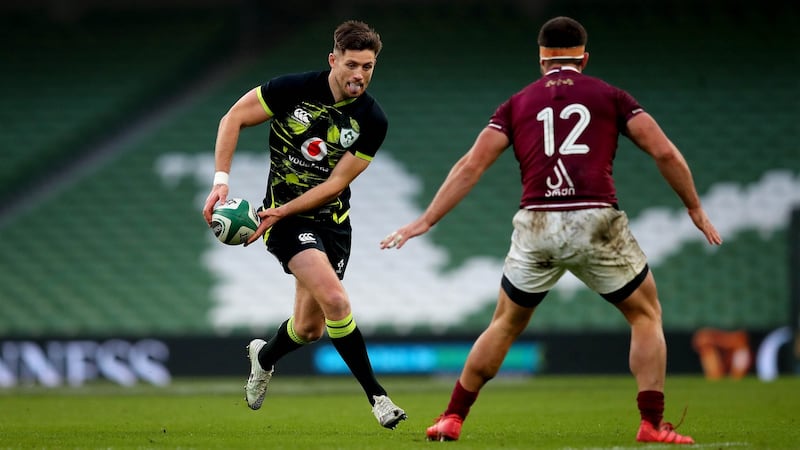All of their own doing, Ireland find themselves in deep waters. They are struggling to cope in the here and now, with an unclear strategy that is poorly communicated on and off the field.
Getting Paul O'Connell on board as forwards coach, after season one of the Andy Farrell era went so badly, should be commended but a leaking ship plugs one hole only to have to scamper over and plug another. The lineout was repaired but the end game execution in Cardiff can only be described as total disintegration.
Farrell’s blank stare after Wayne Barnes’s full-time whistle spoke louder than any words that followed.
The pillars needed to prop up any successful team are showing cracks: succession planning at outhalf and to a lesser extent scrumhalf appears to be flawed, misguided even.
Gordon D’Arcy: Irish lineout has to move past mess of 2020 for the Six Nations
Gordon D’Arcy: Ireland’s Six Nations could hinge on laying Cardiff ghosts to rest
Gordon D’Arcy: Time for IRFU to be bold and secure futures of prized assets
Gordon D’Arcy: My dementia fears for the future after rugby and the damage done
We can only work off what we are seeing.
It took a red card to rattle the team into action against a malfunctioning and very beatable Welsh outfit.
It is a stretch to suggest Peter O’Mahony inspired all the heroics that followed his sending off at the Principality, but I saw nothing in the opening 12 minutes to suggest Ireland had turned a corner. A poorly struck Conor Murray box-kick from the first attacking opportunity revealed a side solely intent on scraping through the Test match.
Then O’Mahony lost control. At least public opinion has changed since Sam Cane almost took Robbie Henshaw’s head off in 2016.
The onfield reaction from the remaining 14 players was controlled aggression, pure bravery and impressive technical play by the pack.
That is what worries me for the weeks ahead, and France this Sunday in particular; the group needed to be backed into a corner before one individual after another started making big plays.
Robbie Henshaw was sensational. Same goes for Tadhg Beirne and Iain Henderson when charged with filling the gaping holes left by the departure of O’Mahony and James Ryan. It was encouraging to see players in their prime, holding up their end of the bargain.
Billy Burns cannot lay claim to this comfort blanket but I am hesitant to fast-track Harry Byrne because he was not selected in the initial group and it would scream of desperation to parachute him in now. In such a crucial and sensitive position, composure is needed in selection and management of personnel.
However, there needs to be a clear delineation between the second- and third-choice outhalf.

The situation Ireland find themselves in is down to management. From the top down, David Nucifora to Farrell, the professional structures were supposed to ensure that this mess did not occur.
Nucifora put the coaching ticket together. Farrell, presumably, picks the team. We know from Nucifora’s fascinating press conference late last year that he is not focusing on the 2023 World Cup, nor is he losing a wink of sleep about the amateur game, so the priority is 2021.
How is that going?
The performance director has had seven years to avoid what we are currently witnessing. Ireland’s collapse in 2019 was shocking for everyone and stumbling from one disaster to another in 2020 came with plenty of legitimate excuses, but what now? When will Ireland’s lack of a long-term strategy be explained? How long does the Australian plan to stay in his position of power?
This is a bigger problem than the public realise.
Two years ago Bernard Laporte removed all the window dressing around Les Bleus by promising to expose young talent – from a rich vein of underage world champions – with a masterplan put in place for Fabien Galthié to deliver the William Webb Eillis trophy in 2023.
That’s why Romain Ntamack was capped as a teenager. Now the difference between Ntamack at 21 and Harry Byrne at 21 is vast. The former has shown his class for Toulouse while the latter is third choice at Leinster.
The lack of succession planning around 10 is an indictment of the system, and this is exacerbated by Burns being ill-equipped to guide Ireland out of a game that was there for the taking. The Welsh lineout was broken and their replacement scrumhalf Gareth Davies even gifted Ireland one last possession.
Burns, as mentioned, is 26. Ross Byrne is 25. Both outhalves have been given opportunities to prove they are capable enough to follow the standards set by Johnny Sexton and Ronan O'Gara.
How you show up under pressure is how you must be judged.
Existing at the elite end of sport is an IRFU ambition, right? If this was an NFL franchise one of two things would happen after Sunday's game or after Twickenham last year. The second-string quarterback would be cut or someone on the coaching staff – the person in charge of recruitment perhaps – would be given his exit papers.
Joey Carbery’s year-long injury removed a valuable safety net. The latest trapeze artist just fell off the high wire.
Like the QB, outhalf is the one position the coach must get right. Everyone’s job prospects depend on it. Athletes make mistakes but three unforced errors in the last 10 minutes of a massive Test match is impossible to gloss over.

Clearly, outhalves do not grow on trees in Ireland. The recruitment of Burns was a direct result of Paddy Jackson being sacked by the IRFU in 2018. It was a huge opportunity for the player as Gloucester had just signed Danny Cipriani.
This was his big chance to prove himself. If Sexton is unable to come through the return to play protocols – after being kneed in the temple by Justin Tipuric – then Farrell has to go give Burns or Ross Byrne another chance.
Whoever gets picked needs to exude confidence, coming from a deep understanding of how they want to play and pushing others to where they need them to be. The public needs to see a narky, confident and defiant leader.
The “next job” mantra does not wash this week. Nobody turns the corner after this sort of defeat. Not in seven days.
The hurt can be harnessed into a performance against France but all the unity and friendship that emanates from the group can only take them so far. Gary Keegan and the support staff have their work cut out this week.
Nor can we say that Sexton was a beacon of light before he was forced off. I went back to his performances in 2018 and the difference is stark. On Sunday he played static on the gainline but the Welsh defence rarely looked interested. They were happy to push off him, and focus on ball carries with a hard press. He couldn’t get them to bite and it stymied the attack.
With Sexton so flat, and multiphase play from scrumhalf unable to break the gainline, Ireland have become predictable again. The idea of a second playmaker disappeared with Carbery.
The outhalf conundrum is liable to leave them scrambling for a third or fourth place finish this season. Scotland should beat Wales on Saturday and after a trip to Paris they will be licking their lips at the prospect of finally putting one over on Ireland at Murrayfield on March 14th.
Cameron Redpath was a class act at Twickenham but it is the Scottish pack that I am worried about.
None of this comes as a surprise. Last week I wrote about the pressure on Farrell’s management to deliver a coherent game plan. I fretted about the yawning gap in quality between the injury-prone outhalf and his replacement. The worry is we may be repeating ourselves for a while yet.
An impossible selection awaits for Farrell; stick with Burns despite mounting evidence that he lacks the calmness or accuracy required to soften the cough of a rampant France or switch back to Ross Byrne, again.
If it takes another red card for the team to show up, Antoine Dupont will rip Simon Easterby’s defensive system to shreds.
To be relying on graduated return to play protocols this week in order to get Sexton and James Ryan onto the field is not a good look. Some players may need protecting from themselves. Some coaches may need protecting from the players.
I hope this column is shoved down my throat on Sunday. I hope they turn the corner with a famous victory, inspired by No10, but the evidence of the opening 12 minutes indicates a deeper malaise.















